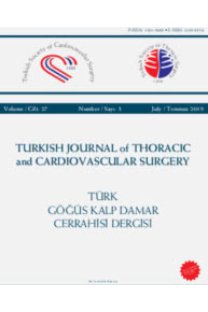Bronkoplevral fistüller: Zorlu bir komplikasyon, 50 hastanın sonuçları
Bronchopleural fistulas: a challenging complication, results of 50 patients
___
- Zakkar M, Kanagasabay R, Hunt I. No evidence that manual closure of the bronchial stump has a lower failure rate than mechanical stapler closure following anatomical lung resection. Interact Cardiovasc Thorac Surg 2014;18:488-93.
- Sarkar P, Chandak T, Shah R, Talwar A. Diagnosis and management bronchopleural fistula. Indian J Chest Dis Allied Sci 2010;52:97-104.
- Tezel Ç, Ürek Ş, Keleş M, Kıral H, Koşar A, Dudu C ve ark. Bronş kapama metodlarının güvenilirlik sınırlarının bir hayvan modelinde saptanması. Turk Gogus Kalp Dama 2005;2:140-5.
- Cerfolio RJ. The incidence, etiology, and prevention of postresectional bronchopleural fistula. Semin Thorac Cardiovasc Surg 2001;13:3-7.
- Yeginsu A. Akciğer rezeksiyonlarında elle yapılan bronş kapama teknikleri. Turk Gogus Kalp Dama 2008;2:133-9.
- Uçvet A, Gursoy S, Sirzai S, Erbaycu AE, Ozturk AA, Ceylan KC, et al. Bronchial closure methods and risks for bronchopleural fistula in pulmonary resections: how a surgeon may choose the optimum method? Interact Cardiovasc Thorac Surg 2011;12:558-62.
- Yörük Y, Mehmet R, Köse S. Akciğer cerrahisinde staplerin yeri. Turk Gogus Kalp Dama 1995;1:86-8.
- Ng CS, Wan S, Lee TW, Wan IY, Arifi AA, Yim AP. Post- pneumonectomy empyema: current management strategies. ANZ J Surg 2005;75:597-602.
- Tedde ML, Scordamaglio PR, Minamoto H, Figueiredo VR, Pedra CC, Jatene FB. Endobronchial closure of total bronchopleural fistula with Occlutech Figulla ASD N device. Ann Thorac Surg 2009;88:25-6.
- Yang L, Kong J, Tao W, Song Y, Huang T, He F, et al. Tuberculosis bronchopleural fistula treated with atrial septal defect occluder. Ann Thorac Surg 2013;96:9-11.
- ISSN: 1301-5680
- Yayın Aralığı: 4
- Başlangıç: 1991
- Yayıncı: Bayçınar Tıbbi Yayıncılık
Rib fracture posing risk for aortic rupture
Nesimi GÜNAL, Koray DURAL, Tevfik KAPLAN, Berkant ÖZPOLAT, Ekin ZORLU
Sinüs Valsalva anevrizmalarının cerrahi tedavisinde 16 yıllık deneyimimiz
Ferit ÇİÇEKÇİOĞLU, Cemal Levent BİRİNCİOĞLU, Ufuk TÜTÜN, Mustafa PAÇ, Bayram YILMAZKAYA, İrfan TAŞOĞLU, Aytaç ÇALIŞKAN, Alaa HAJAZİ
A rare internal jugular vein phlebectasia: Review of the literature
Hamit Serdar BAŞBUĞ, Ahmet ERDEM, Kanat ÖZIŞIK, Hakan GÖÇER, Yalçın GÜNERHAN
Erhan KAYA, Ömer IŞIK, Hakan FOTBOLCU, Cevat YAKUT
A giant pulmonary artery aneurysm associated with congenital keratoglobus
Bilgin EMRECAN, Tevfik GÜNEŞ, Gökhan PEKEL, İhsan ALUR
Thoracic splenosis diagnosed 48 years after thoracoabdominal trauma
Ali VERAL, Alpaslan ÇAKAN, Kutsal TURHAN, Ufuk ÇAĞIRICI, Ayşe Gül ERGÖNÜL, Yeliz EROL
Travma sonrası karaciğerin bütün olarak fıtıklaştığı sağ yerleşimli gecikmiş diafragmatik fıtık
Akın Fırat KOCAAY, Murat ÖZKAN, Serkan ENÖN, Tamer DİREK
Uğur AKSU, Fevzi TORAMAN, Melis TOSUN, Halim ULUGÖL, Murat ÖKTEN, Cem ARITÜRK, Hasan KARABULUT
Pulmoner otogreft mitral kapak replasmanı için ne kadar ideal?
Kemal UZUN, Denya MANSUROĞLU, Mustafa GÜLER, Suat Nail ÖMEROĞLU
Çocukluk çağı aort koarktasyonu tamirinde farklı cerrahi tekniklerin karşılaştırılması
Ömer Faruk ÇİÇEK, Murat KOÇ, Hakan AYDIN, Mehmet TAŞAR, Vehbi DOĞAN, Sercan TAK, Ali KUTSAL
